By
Tomas Mc Rae, Brisbane, Queensland, Australia, ©2008
A revision with a postscript of his 2001 masonic lodge lecture
and his 2003 article in Philalethes
Magazine
[This
article is featured in the Lowlands-L Gallery collection as well.]

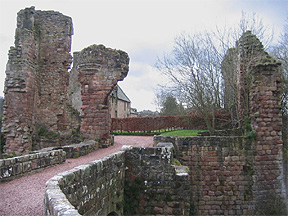 Entrance
to Roslin Castle, near Edinburgh, Scotland
Entrance
to Roslin Castle, near Edinburgh, Scotland
(Photo: Supergolden) |
ere’s
a recipe to make a fortune. Mix together extravagant tales involving Scotland, Freemasonry, and Knights Templar. Season with some ancient Egypt and garnish with the odd lost scroll. Assemble this into the most outrageous story you can envisage then … get it published. There are already many success stories using this recipe, why not you?
Masonic history has been described in The Economic History Review as “a department of history which is not only obscure and highly controversial, but by ill luck the happiest of all hunting grounds for the light-headed,
the fanciful, the altogether unscholarly and the lunatic fringe of the British Museum Reading Room.”
How
true is this for the Roslin area and the Knights Templar? Ian Rankin, world
famous thriller writer, says in his novel Set in Darkness … “Roslin was the home of the ancient and extraordinary Rosslyn Chapel which
in recent years had become the target of a range of millennialist nutters.”
A typical local view of the place.
Unlike
most of those “nutters” I was born and educated in Scotland and lived for
many years within a bike ride of Roslin village. There’s a nebulous connection
with my family as my Great Great Grandfather managed a gunpowder-mill there
until it blew up … After that he taught the fiddle.
Let’s
begin with Rosslyn Chapel, started by William Sinclair around 1446 and
developed by his son Oliver to its present state in the 1480’s, lack of
funds probably stopped the project’s completion. Frankly any claims that
this wonderful building has strong connections with Freemasonry must be
taken with a bucket of salt. I concede however there had to be a settlement
of Stonemasons during the construction of, first the castle, then the Chapel
but there are no reliable records confirming this.
It’s
claimed that Cromwell’s General Monck destroyed the Castle but left the
Chapel alone as he and Cromwell were Freemasons. Total bunkum! The Castle
was wrecked due to its strategic importance Cromwell was not into destroying
churches and Monck stabled his horses in it while some of his senior officers
looted the extensive library. Hardly Masonic acts. There is not the slightest
evidence that Cromwell or Monck were Freemasons.
Carvings
illustrating biblical messages to an illiterate population. are commonplace
in Medieval churches all over Europe, In The Second Messiah Knight and Lomas claim there are no Christian symbols in the Chapel. They must
be blind! There are several crosses around the place as well as angels
and Bible illustrations in stone. One group they claim as The Turin Shroud”
is actually a portrayal of St Veronica wiping Christ’s face when his image
was superimposed on the cloth. Is this Christian enough? They do not seem
to have much knowledge of Christian traditions.
I
have not only visited the Chapel but have been given a conducted tour by
the then Minister, long before they charged the admission admission fee
I had to pay in 2004. He took me round and explained many of the carvings,
making no mention of anything masonic.
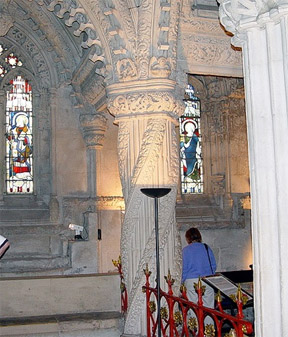 The
Prentice Pillar (Photo: Thomas Mc Rae)
The
Prentice Pillar (Photo: Thomas Mc Rae) |
Among
other things I saw the famous “Prentice Pillar” which has a fascinating
tale to tell. Legend tells how at the construction of the Chapel the Master
Builder, being confused by plans that included a mysterious pillar, travelled
to Italy to consult with the architect, leaving his apprentice to work
on his own. During his Master’s absence the apprentice thought long and
hard about the pillar and is said to have had a dream where angels showed
him its true form. He managed to complete it but when the jealous Master
saw the wonderful work he killed the poor lad with a mallet. The apprentice’s
widowed mother saw the crime committed and The Master was supposedly hanged.
Some
claim the account is allegorical, symbolising the Apprentice passing to
a new life as a Craftsman. Whatever the tale is just a myth also attached
to several churches and cathedrals in Britain and Europe.
It
is so easy to find masonic connotations where none exist … as Freud said “Sometimes a cigar is just that ... a cigar.” Maybe someone should have told this to Monica Levinsky … In recent times the Chapel has been associated with Templars, UFO’s, The Holy
Grail, The Turin Shroud, only thing missing so far is an Elvis appearance
and I’m working on that. I find it significant that the official website
for the Chapel .rosslyn-chapel.com/ make no mention whatsoever of Masonic, Templar, or even Elvis connections.
On
to the St Clair or Sinclair Family. It is claimed that members were hereditary
heads of Masonry in Scotland, calling an annual assembly of Scottish Lodges
at a small village called Killwinning. David Murray Lyon, Grand Secretary
of The Grand Lodge of Scotland, 1887–1900, demonstrated that claims of the Family having any territorial rights on
Killwinning area in Scotland’s West are dubious. Remember that Lyon had
access to all existing documents. St Clair lands were in the East and in
Orkney.
Masons
journeying to Killwinning from all over Scotland would have faced wild
beasts, brigands, disease, and hazardous terrain. Some would also have
had to traverse the huge Selkirk forest long since destroyed. For over
a century the whole area was the scene of almost constant Scots/English
wars with attendant mayhem and travellers would have required armed retainers for protection. We must also ask where
all those Masons stayed in this tiny hamlet and where they held their Assemblies?
It
is claimed that in the15th century James II of Scotland appointed William
St Clair and his descendants hereditary Protectors of Scottish Masons which
probably made them their patrons and arbitrators. Gould and Lyon play the
claims down. As does Robert Cooper the current Grand Librarian of the Grand
Lodge of Scotland. The only evidence supporting this is a letter written
in the reign of James VI by William Schaw his Master of the Royal Buildings
making those claims and requesting the current William to resume that patronage.
Said William did nothing about the appeal being too busy fleeing the wrath
of an angry miller whose daughter he had seduced.
During
the reign of Charles II, William’s son received a second appeal but when he tried to have this appointment confirmed by the King it was speedily rejected as without foundation.
Nonetheless,
in 1736, the William of that time renounced all claim to this masonic title, and was initiated into Lodge Canongate Killwinning, in Edinburgh, then elected first Grand Master of Scotland. Obviously he had not been
previously Made Mason. William was the last of his line, had none of the
titles enjoyed by his ancestors, but is reported as being a great gentleman.
He
sold both Castle and Chapel for much needed funds but, if the Chapel really
had strong Masonic connections, surely steps would have been taken by Scots
Freemasons of the time to maintain it? In fact no real maintenance took
place until the late 18th century.
Onwards
to The Knights Templar or The Poor Knights of The Temple of Solomon to
give them their full title. The Order was founded as a fighting monastic
discipline protecting Pilgrims to Jerusalem. Other Orders including those
of St John, Lazarus, and The Teutonic Knights were among warrior monks
dedicated to this task. These Orders also did great work establishing hospitals
for sick pilgrims.
Templar
Knights lived under strict discipline, subject to the Pope alone with no
other Church or Civil Authority able to touch them, truly laws unto themselves.
In time the Moslems expelled most Christians from The Holy Land but The
Order had vast land resources in Europe and Cyprus so many of the fighting
men moved to that lovely island.
As
well as being warriors the Order organised an efficient system of money
transfer from the Holy Land to various European destinations. In time they
began issuing loans which increased their wealth while reducing that of
their creditors. This, and their arrogance, would lead to the destruction
of The Far From Poor Knights. Allegations of homosexuality and witchcraft
had already been made against the Teutonic Knights, forcing them to move
to Prussia. Similar accusations involved the Templars in France and advantage
was taken of these rumours to begin the Order’s annihilation.
France’s
King Phillip the Fair coveted Templar wealth and began illegally arresting
members of the Order. He then induced his puppet Pope Clement V to start
proceedings against them. Mass arrests started in 1307 the same year that
Edward I of England died. Confessions were extracted under the foulest
tortures and this evidence convinced the Pope of their guilt. He dissolved
the Order commanding European rulers to round up all Knights in their domains.
Edward
II destroyed the Order in England and in parts of Scotland where he still
occupied large areas of the country. Templar refugees in Bruce’s lands
would hardly have received sympathetic treatment, having helped Edward
I defeat Wallace at Falkirk then Bruce at Turnhouse near Edinburgh. Aye,
Bruce had scores to settle with the English-supporting Knights!
Edward
II grabbed most of the Knights’ wealth and lands just as Phillip had done
in France. Tales of vanished Templar treasure are just that, as are the
myths of surviving Templars settling in the Scottish Highlands. The Knights
more probably vanished into continental urban communities. Some may even
have been admitted to other Orders especially in Portugal where they continued
under new names but there are no records of any Post-Persecution Scottish
settlement..
The
Pope decreed the Knights of St John were to receive the bulk of Templar
property. Edward and Phillip however held on to their loot for some time
before disbursing portions to the new owners. By 1314 Templar leaders including
Jacques de Molay had been brutally executed and the once great Order was
no more. King Phillip and Pope Clement died shortly afterwards, and Robert
Bruce eventually gained control of Scotland. Those are the facts accepted
by competent historians, yet a convoluted mythology persists.
Gould
in his History of Freemasonry tells how Dr Anderson started off the Templar legend in his Book of Constitutions. Anderson made numerous other claims making everybody from Moses onward Freemasons,
he had a a good imagination. Mackey’s Encyclopaedia tells how the Chevalier
Ramsay elaborated the myth in his own Rite “to give Freemasonry some sense
of nobility” but by the 1800s the Templar myths had been dismissed, but
alas not once and for all.
A
later authority, Coil, (Freemasonry Through Six Centuries) dismisses … “the chivalric or military theories, which are detected to be quite fanciful … there was never the slightest evidence of any such element in Freemasonry until
it was added during the multiplication of degrees in the eighteenth century’.
Despite all those disclaimers Templar myths keep coming up like badly cooked
sausages at a barbecue. It really is time they were flushed away for good.
At
the time of the French Revolution Templarism re-appeared after a French
eccentric Bernard Raymond Fabré-Palaprat decided he was the living successor
of Jacques de Molay, producing a fake document to prove his claim. Known
as the Larmenius Charter it first made its appearance in 1805 and claimed
that de Molay appointed a Jean Jacques Larmenius as his successor prior
to his execution. How Larmenius managed to visit Jacques in a secure prison
to get this appointment borders on the miraculous.
Out
of those dubious claims The Order of the Temple re-appeared and Palaprat
made a fortune in fees. He ended up proclaiming himself Pope...nuff said!
His Order survives to this day but became a Christian charitable organisation
which denies any connection with the Knights Templar. I suspect it was
some of those Templars who guarded a lump of rock in a Scottish church
for years, claiming it was the REAL Stone of Destiny
Aye,
crazy claims persist involving the Old Warriors.
Last
September at an assembly of Scots Masonic Templars in Stirling a lecture
delivered by a Bro Robert Lomas purported to tell the true story of the
origins of Freemasonry. Lomas and his partner Knight have written idiotic
books. laughing all the way to the bank while filling our minds with nonsense.
 The
Prentice Pillar chapter with angels and the controversial rectangles (Photo: Thomas Mc Rae)
The
Prentice Pillar chapter with angels and the controversial rectangles (Photo: Thomas Mc Rae) |
The
Hiram Key, The Second Messiah, Uriel’s Machine … Don’t waste your time or money. Authorities have dismissed them as rubbish.
I
do concede however that The Hiram Key and The Second Messiah combine to give their readers a very important message. Do not try using dictionaries
for languages with which you are unfamiliar to support nebulous theories.
I
refer to their allegations that they found Masonic secret words when perusing
Ancient Egyptian dictionaries. In the second book they inform us that they
studied Gaelic dictionaries to find that Rosslyn means “Inherited Wisdom.” Apart from anything else
Lowland Scots was the language of the Scottish Lowlands. Only in the area
of Galloway are there claims of Gaelic being the common language of a Lowland
population.
The
two words forming the name are much more probably “Ross” the name of a
person. but with the European Lowlands influences on Scots dialect it could
also be “horse.” “Lynn” is a word used in Scots for a waterfall and occurs
in Burns poem “My Hoggie,” ie “We heard naught but the roarin’ lynn amang the braes sae scroggy.” In Scots myth we also have the famously randy
Tam (o’ the) Lynn.
Our
friends state there are no waterfalls anywhere near the village, fact is
the adjacent gorge was formed by two rivers and a fall remains at their
confluence. Baigent and Leigh mention this in “The Temple and the Lodge.”
The
text of Lomas’ lecture is given in full on his Web Site, included in the references at the
end of this paper. He claims surviving Templars, and their relics, arrived
in Scotland and that William St Clair built Rosslyn chapel to store them
on their behalf.
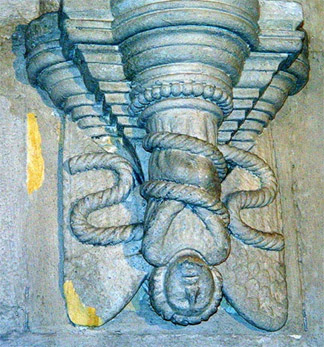 The
Fallen Angel (Photo: Thomas Mc Rae)
The
Fallen Angel (Photo: Thomas Mc Rae) |
Claims
are also made that the Chapel is an exact replica of King Herod’s Temple
and conceals important artifacts, found by Templars in the foundations of that ancient structure. He continues to state that, with the cooperation of the St Clairs, Templars founded Freemasonry which therefore did not exist in England until James VI, a Freemason, went to England in 1603, as James I.
The
Grand Lodge of Scotland has records going back to the 16th century, there
is no mention in them of James ever having been a masonic initiate. Lomas
next claims that after the Jacobite Rebellion of 1715 the English founded
the first Grand Lodge to dissociate themselves from the rebellious Scots.
Ireland followed suit, then Scotland finally established its Grand Lodge.
What a collage of myth, speculation, and bent history!
Let’s
start with the Templar presence in Scotland …
In The
Temple and the Lodge Baigent and Leigh claim they found Templar graves in the Wester Ross area of
the Scottish Highlands. How valid is their discovery? As the gravestones
they found have no inscriptions they state this proves them to be Templar.
In
fact most mediaeval people were illiterate so inscriptions on tomb stones
were rare. I concede that some of the stones have swords inscribed on them
but not only Templars had swords. They were scarce, expensive items and
one inscribed on a grave stone showed the high status of the deceased.
The Museum of Scotland states that a sword on a gravestone often denoted
A Soldier of Christ. In one example at the Museum we have a child’s grave
from 13th century.
Baigent’s
most “convincing” proof is the finding of stone “Templar” crosses at several
sites and even a gravestone showing a Templar “admiral.” No way, José!
Remember Freud’s cigar? Stone crosses of this type are found all over Scotland
and Ireland, some dating from at least the 6th century. They are classic
examples of Celtic art carved long before any Templars appeared on the
planet. The cross on Baigent’s photograph of an alleged stone of a Templar
“admiral” shows typical Celtic knot work predating the Templar era.
The
subject’s armour is similar to that on Iona’s 8th century warrior carvings,
while the boat displayed is the longship design used by the local seagoing
people. An alleged Masonic Square is more probably a heraldic chevron showing
the warrior’s nobility, and the subject does not have the mandatory Templar
beard.
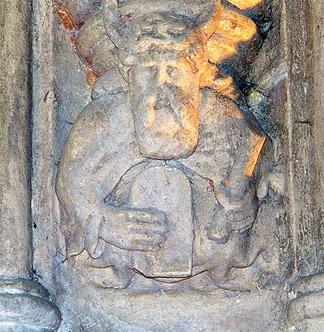 Horned
Devil? No, it's Moses and The Commandments
Horned
Devil? No, it's Moses and The Commandments
(Photo: Thomas Mc Rae) |
Kiwi
Baigent and American fiction writer Leigh’s claims prove just one thing
their ignorance of Scottish culture.
The
Medieval Highlands were populated, not by kilt-wearing, haggis-eating, caber tossers, but by a wild aggressive people who fought at the least provocation. (Just as they still do in Glasgow and Edinburgh pubs). Strangers tended to die quickly until after the 1715 Rebellion when law and order finally started taking hold.
Could
a mob of Templar refugees really wander into a glen of Gaelic speakers
and settle in such lawless country? Any influx of strange men would have
been regarded as rivals for attentions of the available women. Outsiders
had scant hope of long-term survival no matter how tough they were in such
an environment. Highland Scots have a long established bardic tradition
yet there are no accounts of an influx of settlers from beyond the sea
in the songs or ballads.
So
what about the Lowlands? Pretty much the same outside the large towns.
Remember the Scots were only just throwing out the English who the Templars
had supported, I doubt if Scots would have accepted recent enemies as neighbours.
Apart from anything else would people from the warm Mediterranean exist
happily in a cold, wet, misty land like Scotland?
I
defy anybody to find the slightest trace of latter-day Templar settlement
in Scotland. Scottish historians and archivists have yet to find anything
relevant despite popular writers making “discovery” after “discovery.”
Great play is made in some masonic traditions of Templars fighting at Bannockburn.
In The Temple and the Lodge Baigent claims their arrival on the field was enough to send the English running.
The
scant accounts available actually tell how the English, already in deep
trouble, fled when large numbers of reinforcements were seen approaching.
This force was probably Bruce’s second Reserve comprised of largely untrained
but keen volunteers. To keep them out of trouble these were assembled some
distance from the main combat zone..
When
the so-called Little People saw the English starting to falter they moved
in. and the tired and bloody English soldiers broke and ran. Nary a Templar
in sight! Contemporary records prove this story, there’s no mention of
Templars and the Scots were perfectly capable of defeating the English
without the help of foreigners with no knowledge of the terrain.
In
any case by the time of their dissolution most veteran Templar warriors
were slain leaving inexperienced recruits as replacements. William Wallace
killed the Grand Master of the English Templars with ease in single combat
during his resistance to English rule. Latter day Templars were hardly
the formidable warriors of yesterday.
On
to the Chapel and back to Lomas. An exact replica of King Herod’s Temple?
Have a look at any pictures of the Chapel; see the buttresses? There were
no such things in architecture until medieval times or was Herod a prophet?
Frankly we have little idea of what The Temple looked like apart from Josephus”
written accounts of its massive structure. No drawings exist and the only
remaining trace is Jerusalem’s Wailing Wall which gives some idea of the
size of the original.
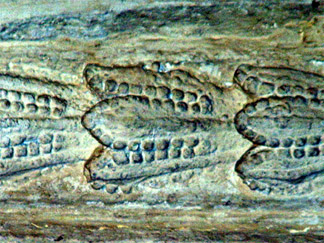 American
maize (corn)? Actually the seed pods of some flower, probably goldenrod
(Solidago virgaurea minuta).
American
maize (corn)? Actually the seed pods of some flower, probably goldenrod
(Solidago virgaurea minuta).
(Photo: Thomas Mc Rae) |
Herod’s
Temple was razed by the Roman Commander Titus Vespasianus when he suppressed the Second Maccabean revolt at Jerusalem in 70 AD. Hadrian destroyed the last traces after the revolt of 135 AD and had the Roman city
of Aeolia Capitolina built on the site. Anything portable was looted by the Romans, as commemorated on Titus’s Arch in Rome. Christ’s prophecy of the wonderful building’s destruction proved all too true less than 40 years after He made it.
The
Temple was built on solid rock and accounts of networks of foundations
and secret underground labyrinths are figments of the imagination. Rosslyn
Chapel is tiny by comparison and its architecture is classic Mediaeval;
buttresses, vaulted ceilings, arches, and all. I defy anyone to show how
this small structure can be an exact replica of a much larger Jewish Temple,
particularly as it remains unfinished.
Work
on the Chapel started over 100 years after the destruction of the Templars
so where were the Knights and their treasure in the interim? Maybe a secret
Templar ship landed the stuff? In the 1400’s? Even assuming this unlikely
event why transport valuable material from the Coast to remote Roslin?
Which port was the material landed at? The Scottish coast then as now was
wild and stormy.
Nowadays
you can walk to Roslin from Edinburgh in perfect safety, so long as you
stay on the pavement. Then, in the midst of the Pentland Hills, it was
a wild area. Rebels and robbers abounded in the Lowlands and tracks were
pretty rough.
Lomas
shows a photograph of a badly worn carved group in the Chapel which he
claims portrays a Candidate’s Masonic Initiation by a Templar.
John
Hamill, United Grand Lodge of England’s Grand librarian at the time’s statement that this is coincidental is dismissed by Lomas as English prejudice yet
he himself comes from Manchester. Must we also dismiss the evidence of
Gould and Lyon as English prejudice?
In
the carving one man kneels while another stands beside him holding a rope
that is tied round the kneeling person’s neck. The standing figure has
a cross on his tunic while the kneeling one holds a rectangular object
with a cross on it. This allegedly depicts a candidate taking his Obligation
on the VSL? Not so if you know your mediaeval history.
First
to The Templar. Sure he bears a cross on his tunic but so did many men at arms. This is a simple
cross not the wide apex type adopted by the Knights and he does not have
the long beard required by Templar Rule. Finally he and the Kneeler both
wear hats, hardly the thing when taking a sacred Obligation.
As
to The Candidate, aye, he has a rope around his neck. Lomas reveals his ignorance when he claims
the only other figure of “the period” with such a cord attached is a famous
bronze known as “The Dying Gaul.” In fact The Gaul is from Ancient Greece
and has a bronze torque around his neck, a sculpture considerably earlier
than Rosslyn’s stone carvings. How can anyone fall for this man’s books
when he cannot even get such a simple claim correct?
The
Kneeler holds a Bible? … Does he really? Let’s think this out …
Gutenberg
had yet to launch his moveable type revolution and books, still laboriously
written out in monasteries, were very valuable The taking of oaths was
done on sacred objects, mainly relics or tombs of holy men. Oath taking
on the Bible probably started in Britain with the introduction of The King
James Bible after 1603..
What
does this carving really portray? We’ll probably never know but it is not
a Masonic initiation. It may be an illustration of some Biblical theme,
the Commandment “Thou Shalt Not Steal” is a possibility. Or is it part
of the famous series in the Chapel portraying The Seven Deadly Sins.
The
so called “Bible” could be a reliquary box for holy relics or some other
precious item the holder has stolen.
Lomas
in his website uses some very bent probability statistics to prove his
claims. The same data can be used to prove the contrary, that the carving
predicts the coming of Elvis, or just about anything else you want There
are lies, damned lies, statistics, and Lomasian mathematics. Check his
website for yourself, don’t take my word for it..
What
about English masons distancing themselves from the Scots after the 1715
Jacobite Rebellion? “The 15” was a small Highland uprising soon put down
at the Battle of Sheriffmuir. Many Scots clansmen fought against the rebels
while Lowlanders, where masonry was strongest, were less involved.
Knight
and Lomas claim that the English were concerned at Scots Masons stockpiling
arms to use against England. In other words Scottish Brethren were traitors
to their King and Country,. What an outrageous piece of libel! The dynamic
duo give an extract from an Edinburgh Lodge’s records (in Scots) concerning
a levy to buy such weapons. As usual they misunderstand the truth and show
poor knowledge of the period’s history.
British
Trade Guilds traditionally maintained “Trained Bands” of citizen soldiers
for defence in times of crisis. Members of city trade guilds, or incorporations,
united in such bands. The Edinburgh Incorporations, for example, marched
behind a banner “The Blue Blanket” The bands evolved, first into local
yeomanry regiments, then into the Territorial Army in Britain, the CMF
in Australia and The National Guard in the USA. The enemies the Scots Masons
were arming against were the Jacobite rebels and the French. Our old Scots
Brethren were in fact most loyal subjects of the Crown.
The
records of the London Grand Lodge give detailed reasons for its formation,
no mention is made anywhere of breaking away from a Scots parent body.
Ireland also formed a grand lodge soon afterwards yet many Irish Brethren
were of Scots descent, are you telling me they were also anti-Scots?
Much
imaginative material is woven around the Sinclairs. For example we have
Sir Henry discovering America c.1395. This comes from a handwritten book
in the Vatican library, written two centuries later by a descendent of
the expedition’s supposed Venetian navigator .
Historians
reject this account but, be warned, a recent book claims a lost Masonic
scroll in an Orkney Lodge is a contemporary account of Sinclair’s American
voyage. In fact it Is just a Masonic Tracing Board with some English symbolism
not used in Scotland.
It
is on record that Sir Henry Sinclair, Jarl of Orkney, made a long voyage
somewhere. Soon after his return he, and many of his retinu, were killed in a surprise
invasion by unknown raiders. Allow me do some speculation. I make no claims
to its veracity but it is more plausible than the America’s tale.
For
once I must agree with Baigent who states that Sinclair probably located
Iceland, but what could he have found in this area, what was he doing there? At
the time, and for long afterwards, salt cod was an important staple in
the European diet. The merchants of The Hanseatic League were the only
people who knew its source and it is on record that sailors locating it
were killed by crews of Hanseatic ships.
Rather
than sail for months trying to find a nebulous land I believe that Jarl
Henry’s voyage was an attempt to locate the cod source and make his fortune
and probably he sought something else of importance. Iceland is a volcanic
area where very pure sulphur from eruptions lies for the taking. Such pure
sulphur was needed to make efficient gunpowder. I speculate that Henry
found both cod and sulphur but vengeful agents of the Hanseatic League
killed him on his return to his home base. Even in the mid 20th century
Britain and Iceland fought over cod.
An
earlier William St Clair, so Lomas says, was entrusted with taking Bruce’s
heart to The Holy Land in 1329. In fact The Black Douglas was entrusted
with the task although St Clair was one of an escort of Scots nobles accompanying
him. All save one of the Douglas Party died fighting bravely against the
Moors in Spain.
Lomas
makes this William Grand Master of the Scottish Templars although they
were not only celibate but extinct by that time. Any member of the banned
Templar’s would have been arrested as he travelled through Christendom
en-route to Jerusalem.
A
recently made marble plinth in Rosslyn Chapel bears a worn image of an
armoured warrior. The modern inscription states this is William St Clair
Knight Templar. A dubious claim if ever there was one, being only about
a metre in length St Clair must have been a midget. It is more probably
from a child’s grave.
The
Sinclairs were a truly noble family and there’s no need to pile rubbish
and myths on their heads. Let it suffice that one of their number was first
Grand Master of The Grand Lodge of Scotland. Let him, his Family, and the
Da Vinci Code rest in peace.
I
shall now let my Readers do the same. Thank you for travelling this far
with me.
References
MACKIE
J.D. A History of Scotland (1970 edition) Mackie was Professor of Scottish History at Glasgow University
for 27 years and the Royal historiographer for Scotland from 1957 onwards.
The book is still in print and remains a standard work.
MICHAEL
LYNCH A New History of Scotland (1992 edition) Lynch is a Senior Lecturer (Associate Prof) in Scottish History
at Edinburgh University with several standard books behind him
MICHAEL
BROWN The Black Douglases (1998) Brown is a Lecturer in Scottish History at The University of St Andrews,
Scotland’s oldest. He has also written a standard work on James I
A.D.
M. BARRELL Medieval Scotland (2000) Lecturer in Later Medieval History, University of Belfast
ROBERT
FREKE GOULD History of Freemasonry (1887). A good Scot and brilliant scholar
ALBERT
G MACKEY Encyclopedia
of Freemasonry (1946) Mackey put together the first really comprehensive collection of masonic
lore.
BERNARD
E JONES Freemason’s
Guide and Compendium (1977) Masonic scholar, member of the elite Quatuor Coronati Research Group.
HARRY
CARR “The Freemason at Work” (1976) The doyen of English Masonic research
until his death. Travelled to Brisbane to deliver a lecture when in his
eighties.
KNIGHT & LOMAS The
Second Messiah (1999) The most abominable New Age writers I have come across, spewing out crazy
theories based on speculation, spurious claims, and twisted history.
I would rather undergo the tortures of The Inquisition than plough
my way through this rubbish again!
MICHAEL
BAIGENT & RICHARD LEIGH (1989) The Temple and the Lodge. Well researched, well referenced, but the conclusions are highly imaginative
and inaccurate.
DESMOND
SEWARD The Monks of War (2000 Folio Society Edition) The book on all main Knightly Religious Orders up to the present day. The Knights
Templars’ 14th century demise is detailed but no mention is made of any
Scottish settlements. Highly recommended!
GERVAISE
PHILLIPS (1999) The Anglo Scottish Wars.
MARK
KURLANSKY (1999) Cod. Honestly: there is such a book and it is very dramatic reading.
PERIODICAL
“Scots” An excellent glossy magazine published four times a year that
sticks to authentic Scottish lore. You should find it at any good newsagent.
PERIODICAL The
Scots Magazine The first and oldest magazine ever published. Excellent source of information
on Scots lore although some historical articles substitute sensationalism
for fact.
Hard to find in Brisbane newsagents those days.
ACADEMIC
JOURNAL The Economic History Review, November, 1977, page 103.
LOMAS’
Website is at www.robertlomas.com/Freemason/Freemason.html
ROSSLYN
CHAPEL OFFICIAL WEB SITE www.rosslyn-chapel.com/
And
for those interested further information on Lowland Scots may be found at
sandyfleemin.org/grammar/semantics/frequentwirds.asp
Postscript
2008
Since writing this paper I have obtained
a Folio Society Edition of Dr Malcolm Barber’s excellent work The Trial of the Templars.
First published in 1973 by The Cambridge University Press. Folio used the 1993
revision of this work in producing their beautiful edition of 2003. Barber’s
bibliography is vast, incorporating Avignon Papal records of the time, records
from Rome’s grim Castello de St Angelo, and many documents and books from
the 1300’s until around the mid 1990’s in many languages.
Barber’s
scholarship demonstrates just how pathetic works of New Agers such as Knight & Lomas really are. In his Preface to this edition he goes over the vast amount
of work that has been done on the subject since 1973 and sums up thus … “This work has led to a new wave of interest in the history of the Temple and
its final fate, an interest which had waned since the early 20th century.
However, not all this enthusiasm can be described as academic or even historical.
The revival of serious work has been accompanied by a burgeoning of the market
for solutions to “the mystery of the Templars,” a whole subsection of the publishing industry in which the fraudulent and the
opportunistic compete for the attention of the credulous.
This
too has deep roots particularly in the masonic lodges of the eighteenth century,
the conspiracy theories of the period of the French Revolution, and the romantic
novelists of the nineteenth century of which Sir Walter Scott is the great
exemplar. Peter Partner’s The Murdered Magicians provides a serious historical context for this and Umberto Ecco’s novel, Foucault’s Pendulum, an appropriately ironic commentary.”
I
regard this well referenced and superbly written book to be yet another nail
in the coffin of Templar mythology.
In
2006 Robert Cooper Grand Librarian of the Grand Lodge of Scotland totally
demolished the accrued nonsense of centuries with the publication of his
book The Rosslyn Hoax? This brilliant piece of academic writing should finally end the claims of Templars,
Freemasons, etc being associated with Rosslyn Chapel.

